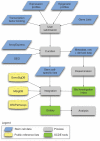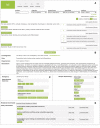The Stem Cell Discovery Engine: an integrated repository and analysis system for cancer stem cell comparisons
- PMID: 22121217
- PMCID: PMC3245064
- DOI: 10.1093/nar/gkr1051
The Stem Cell Discovery Engine: an integrated repository and analysis system for cancer stem cell comparisons
Abstract
Mounting evidence suggests that malignant tumors are initiated and maintained by a subpopulation of cancerous cells with biological properties similar to those of normal stem cells. However, descriptions of stem-like gene and pathway signatures in cancers are inconsistent across experimental systems. Driven by a need to improve our understanding of molecular processes that are common and unique across cancer stem cells (CSCs), we have developed the Stem Cell Discovery Engine (SCDE)-an online database of curated CSC experiments coupled to the Galaxy analytical framework. The SCDE allows users to consistently describe, share and compare CSC data at the gene and pathway level. Our initial focus has been on carefully curating tissue and cancer stem cell-related experiments from blood, intestine and brain to create a high quality resource containing 53 public studies and 1098 assays. The experimental information is captured and stored in the multi-omics Investigation/Study/Assay (ISA-Tab) format and can be queried in the data repository. A linked Galaxy framework provides a comprehensive, flexible environment populated with novel tools for gene list comparisons against molecular signatures in GeneSigDB and MSigDB, curated experiments in the SCDE and pathways in WikiPathways. The SCDE is available at http://discovery.hsci.harvard.edu.
Figures



References
-
- Dick JE. Stem cell concepts renew cancer research. Blood. 2008;112:4793–4807. - PubMed
-
- Reya T, Morrison SJ, Clarke MF, Weissman IL. Stem cells, cancer, and cancer stem cells. Nature. 2001;414:105–111. - PubMed
-
- Bao S, Wu Q, McLendon RE, Hao Y, Shi Q, Hjelmeland AB, Dewhirst MW, Bigner DD, Rich JN. Glioma stem cells promote radioresistance by preferential activation of the DNA damage response. Nature. 2006;444:756–760. - PubMed

